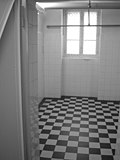Erwin Lambert
Erwin Lambert | |
|---|---|
Sobibór and Treblinka extermination camps during Operation Reinhard | |
| Other work | Mason, Ceramic tile salesman[1] |
Erwin Hermann Lambert (7 December 1909 – 15 October 1976) was a German perpetrator of
Biography
Lambert was born on 7 December 1909 in Schildow, a small town in
Lambert joined the
Late in 1939, the
Construction of gas chambers

Lambert's primary task was to direct construction work at the T4 killing centres, particularly the construction of
After T4's termination, Lambert was posted to
During his testimony at the
I was in the extermination camp of
Treblinka.I went to
Sobibor together with Lorenz Hackenholt, who was at that time in Treblinka. First of all, I went with Hackenholt to a sawmill near Warsaw. There Hackenholt ordered a large consignment of wood for reconstruction in Sobibor.Finally, both of us went to Sobibor. We reported there to the camp commander, Reichleitner. He gave us the exact directives for the construction of the gassing installations. The camp was already in operation, and there was a gassing installation. Probably the old installation was not big enough, and reconstruction was necessary.
Today I cannot tell exactly who participated in the reconstruction work. However, I do remember that Jewish prisoners and so-called Askaries (Ukrainian auxiliaries) took part in the work.
During this time that building was in progress, no transports with Jews arrived.[4]
In addition, Lambert directed construction at several nearby forced labour camps such as Dohorucza and the Poniatowa concentration camp. Reportedly, Lambert attempted to remain an uninvolved expert devoted solely to his work and not interested in the conditions which surrounded it. According to one survivor, Jankiel Wiernik, Lambert avoided looking at dead bodies and treated his Jewish workers in a professional manner.
Unterscharführer Herman [sic] was humane and likeable. He understood us and was considerate of us. When he first entered Camp II and saw the piles [of bodies] that had been suffocated by the gas, he was stunned. He turned pale and a frightened look of suffering fell over his face. He quickly took me from the place so as not to see what was going on. With regard to us, the workers, he treated us very well. Frequently he would bring us food on the side from the German kitchen. In his eyes one could see his good-heartedness... but he feared his friends. All his deeds and movements expressed his gentle soul.[5][6]
At the conclusion of Operation Reinhard, Lambert was posted to Trieste, where he continued installing cremation facilities at the concentration camp Risiera di San Sabba.
After the war, Lambert was arrested on 28 March 1962. At the
References
- ^ H.E.A.R.T. Holocaust Education and Archive Research Team
- ^ ISBN 0-8078-2208-6
- ISBN 3-10-039309-0
- ^ In the Name of the People: Perpetrators of Genocide in the Reflection of Their Post-War Prosecution in West Germany the 'Euthanasia' and Aktion Reinhard Trial Cases. Dick Mildt Publisher: Brill ISBN
- ^ Yitzhak Arad (1987). Belzec, Sobibor, Treblinka: The Operation Reinhard Death Camps, Bloomington: Indiana University Press, p. 196.
- ^ Jankiel Wiernik (1944). A Year in Treblinka, New York, pp. 20-21.
- ^ Treblinka Trial
- ^ Sobibor Trial at the Holocaust Research Project.
External links
